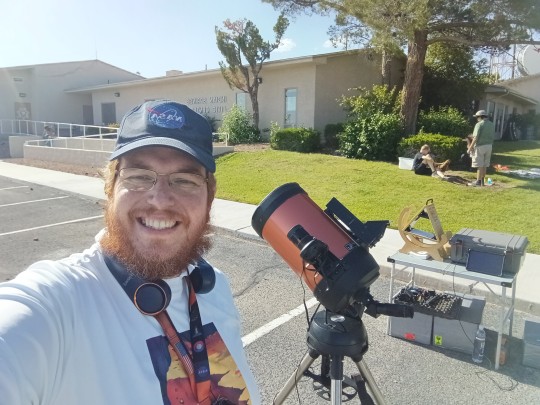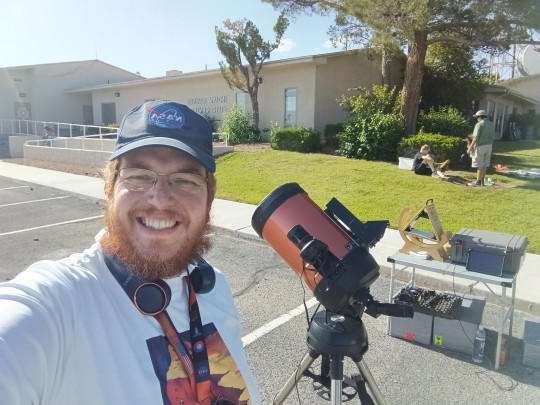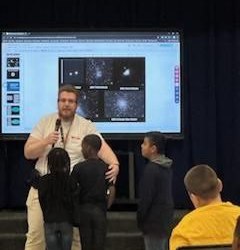Don't wanna be here? Send us removal request.
Text
Today at 1:21 in the morning, we welcomed the winter solstice, marking the longest night of the year. As the Earth tilts its furthest from the Sun in the Northern Hemisphere, we are reminded of the beauty and mystery of our cosmos.
This celestial event has been celebrated across cultures for centuries, symbolizing renewal and the gradual return of light. As we gaze up at the starry sky tonight, let's embrace the magic of the universe and allow the festive spirit to illuminate our hearts, just like the twinkling lights above.
Wishing you all a joyful winter season filled with wonder and warmth!

0 notes
Text
Mars Opposition is Coming! Prepare for a celestial show this winter!
Get ready, stargazers! It has been 2.2 years. It is not the best opposition, but we can try. From late December 2024 to January 16th, 2025, Mars will reach its closest point to Earth (opposition).
This means the Red Planet will be brighter and bigger, and we'll even have a chance to see its icy south pole!
Don't miss this rare opportunity to gaze at the Red Planet's southernmost point. It's a once-in-a-while treat that will leave you starstruck! Share with friends and family who love space, and astronomy, or want to experience the thrill of witnessing something truly cosmic.
Check out this amazing AI-generated image of Mars' south pole!

0 notes
Text
Tonight, we had an incredible discussion about living in space, focusing on the Moon and Mars! The highlight was getting to peek through my telescope, we look at Caldwell 14, Saturn and the Moon. Although clouds played a bit of a trick on us, making Jupiter a little hard to see, the kids and groups still had a blast exploring the cosmos!
Thanks to everyone who joined us for this cosmic adventure. Here’s to more nights filled with stargazing and learning!
#

0 notes
Text
0 notes
Text
Just wrapped up an incredible hike in Fletcher Canyon! This 4-mile round trip took me 4 hours, with sections of medium difficulty that were totally worth it. Gaining an elevation of 991 ft and was rewarded with breathtaking views of a river bed and an impressive gorge at the end.
Nature never ceases to amaze!










0 notes
Text
Epic Journey Across America!
We passed through the majestic mountains of Colorado, the vast plains of Kansas, the lush Hoosier forests, and the breathtaking Appalachian scenery. Every moment was an adventure, filled with awe-inspiring landscapes and unforgettable experiences.










Here's to new beginnings and the road ahead!
From the high deserts of Nevada to the rolling hills of Virginia, we made an incredible trek! In just 3 days, we covered 2,311 miles in 37 hours and 26 minutes of just driving, witnessing the diverse beauty of this country.
0 notes
Text
Exciting Discovery Alert!
Hey space enthusiasts, did you know that NASA's TESS has just uncovered a cosmic wonder?
NASA's exoplanet hunter just discovered a "weird" world named Phoenix that's defying expectations! This hot Neptune-sized planet is surprisingly small, old, and hot - and it's still got an atmosphere despite being super close to its red giant star.
According to the scientists, Phoenix should be a bare rock due to its proximity to the star, but instead, it is emerged from the flames with a nice and puffy atmosphere. It's a real mystery how it's managed to hang on!
Phoenix is part of a rare class of planets that orbit close to their stars, and its discovery shows just how diverse exoplanets can be. The team predicts that Phoenix will eventually spiral into its star in about 100 million years.
What can we learn from this peculiar planet? For one, it's giving us new insights on the late-stage evolution of planetary systems - including our own Earth! Who knows what secrets Phoenix holds about our planet's future?
So, let's get excited about this cosmic discovery and see what other mysteries NASA's TESS spacecraft will uncover!
I left an illustration shows the exoplanet Phoenix in the glare of its red giant parent star. (Image credit: Roberto Molar Candanosa/Johns Hopkins University)

0 notes
Text


Did you know that the Milky Way has over 150 globular clusters?
One of the most striking globular clusters in our Milky Way is Messier 3 (M3) I came across an amazing image of the globular cluster M3 taken with the Vatican Advanced Technology Telescope. For comparison, I share a photo that I have taken through the DWARF II.
Did you know that M3 is a collection of several thousand to millions of stars, all gravitationally bound?
It's approximately 34,000 light-years distant and contains around 500,000 stars!
You can spot it high above the disk of the Milky Way after sunset and before sunrise. Take a look with binoculars or a telescope and see if you can spot T Cor Bor (which is about to go nova, one of these days!)
0 notes
Text
I had an amazing time presenting and sharing the wonders of our solar system through a solar telescope at the Bunkerville Library today!
As part of the Summer Challenge Program, we explored the sun's surface, learned about solar flares, and discovered how our incredible star impacts our everyday lives.
It was fantastic to see both kids and adults so engaged and enthusiastic about astronomy. Your curiosity and questions made the event truly special!
Thank you to everyone who came out and participated. Don’t forget to keep looking up and stay curious. The universe has so much to offer!


0 notes
Text





Excited to support the Summer Challenge at Indian Springs Library! Today, I got to explore the wonders of our closest star, the Sun, using my trusty telescope.
I love observing the Sun's surface and its incredible features. From sunspots to solar flares, it's a reminder of the vast and dynamic universe we’re a part of.
#IndianSpringsLibrary SummerChallenge TelescopeAdventures SunGazing AstronomyLover ExploreTheUnivers
0 notes
Text
Excited to support the Summer Challenge at Indian Springs Library! Today, I got to explore the wonders of our closest star, the Sun, using my trusty telescope.





I love observing the Sun's surface and its incredible features. From sunspots to solar flares, it's a reminder of the vast and dynamic universe we’re a part of.
#IndianSpringsLibrary SummerChallenge TelescopeAdventures SunGazing AstronomyLover ExploreTheUnivers
0 notes
Text

I captured the magic of the full moon through the telescope tonight!
Isn't it amazing how the universe reveals its wonders when we take a closer look? This lunar beauty never ceases to mesmerize me.
0 notes
Text
Had an amazing morning at career Day.
Today, I had a full rotation of classes where I talked to the children about exciting careers in space, the importance of healthy eating, and gymnastics for keeping the bones healthy.
The children were so engaged and curious, I have a few who had fantastic questions. It was inspiring to see their interest in topics like black holes.
One of them tell me that after her PhD, she dreams of becoming a marine biologist on a moon base!




0 notes
Text
A second amazing day presenting at Career Day to a 5 to 8 K group of enthusiastic kids who are eager to explore the mysteries of living on the Moon or Mars!
Their curiosity and insightful questions about space exploration and interplanetary living.
It's incredible to see the next generation so excited about the possibilities beyond our world.
Keep reaching for the stars, young explorers!
#SpaceExploration #MarsColonization #MoonMission #FutureAstronauts #careerdayfun






0 notes
Text
Speech at the Avi Kwa Ame one year Anniversary! To commemorate this special milestone and to reflect on the beauty and significance of our natural surroundings.
0 notes
Text
Interview with Univision Nevada about the parcial solar eclipse event 2024
0 notes